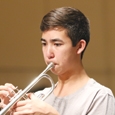How many times have we heard a student say, “If I can just get the first note out I’ll be okay?” This inevitably leads to practicing the same starting note over and over again backstage before a performance. Sometimes it works; the musician goes out on stage and nails it. Other times, the musician gets frustrated and upset when he misses the note in the final minutes of a practice season and goes out on stage anxious and worried about it. First notes theoretically are no different from other notes; a note is simply a vibration. However, musicians tend to miss first notes more than the notes that follow. Few of us ever practice starting first notes. If we miss a first note in rehearsal or during a practice session we can simply start over and try it again, but missing a first note in a concert can make a student upset or embarrassed.
The tongue getting in the way of the air is the primary technical struggle of beginning band students. Many students equate the word attack with force. Practically speaking, the tongue attacks the embouchure while obstructing and stopping the flow of air. This is problematic because it is the air that starts the note, not the tongue. The tongue should simply interject with the airflow to provide definition and clarity to the beginning of the note. The following one-minute exercise will help students develop consistent and confident first notes.
Have the student choose an easy and comfortable note to play. Ask him to play the note by beginning it with the breath alone (a hah articulation). It might help to have him imagine blowing out candles on a large birthday cake. Following a few successful attempts at this, have the student play two connected notes. The first note should still be started with the breath attack (hah), while the second one should be started with a soft, legato attack (dah). For soft, legato attacks I have found it helpful to have students conjure up the memory of having a cavity filled; students will likely keep the tongue relaxed while imagining a mouth full of Novocain.
Once the student has successfully played these two notes, have him play the two notes again using a marcato attack (tah) for the first note and a soft, legato attack (dah) for the second note. Have the student think of the “Ta-da!” sound that occurs at the circus after a stunt has been completed. The ta is a fast motion that gets to the da quickly. The final step is to have the student begin a single note only with a soft legato attack (dah), while staying relaxed. I have found it helpful to imagine the pendulum inside a grandfather clock when preparing first notes. The inhalation of air does not stop until the exhalation of air begins the note.
Over time, students will find that there is no mystery or secret to starting first notes. It just takes some time and consistent hard work to build up the confidence and muscle memory needed to successfully begin first notes. This exercise should gradually be extended throughout the entire range of the student’s instrument, while always playing with the best sound.
Editor’s Note: The Minute Clinic offers quick ideas for techniques to improve basic aspects of playing. Regular application of these ideas in just a few minutes each rehearsal can yield great benefits. Directors are invited to share their favorite exercises and activities. Email: editor@theinstrumentalist.com.





